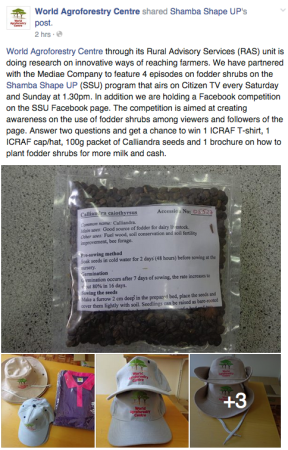- Ah, summer and its funny medieval holidays.
- Making bread in Tajikistan.
- Making pizza in Sussex.
- Making cheese in (one village in) Sweden.
- Diversifying bananas in Queensland.
- Diversifying banana products in Kenya.
- Diversifying with trees in China.
- Better diversify coffee.
- I see your responsible soy and raise you responsible oil palm.
- Cocks of the walk.
- I’m so annoyed the New Scientist article on breeding less bitter veggies is behind a paywall that I won’t even link to it. Google it, if you must.
Brainfood: Vavilov then & now & always, Helmeted fowl diversity, MLND resistance, Sorghum diversity, Facilitation, Rice yields, Biodiversity services, Wild tomato diversity, Date diversity
- In the Footsteps of Vavilov: Plant Diversity Then and Now. The Pamiri Highlands of Tajikistan, the Ethiopian Highlands, and the Colorado Plateau of Southwestern North America compared at time of Vavilov and now: “Localities that have retained diversity have suffered the least.”
- Vavilovian Centers of Plant Diversity: Implications and Impacts. “His concept of specific centers of origin for crop plants was not an isolated aphorism but has directed breeders, on their study and reflection, to the continued improvement and economic development of plants for humanity.”
- Mitochondrial DNA variation of Nigerian domestic helmeted guinea fowl. Recent domestication, and lots of intermixing mean not much diversity, and what there is doesn’t have structure.
- Genome-wide association and genomic prediction of resistance to maize lethal necrosis disease in tropical maize germplasm. That’s when two viruses attack synergistically. Resistance is from multiple loci with smallish effects, and there are some promising markers.
- Genome-environment associations in sorghum landraces predict adaptive traits. Genotype predicts drought tolerance.
- Facilitation and sustainable agriculture: a mechanistic approach to reconciling crop production and conservation. Understanding facilitative plant–plant interactions (intercropping, varietal mixtures) in crops leads to more sustainable farming practices. Or it could.
- The relative contribution of climate and cultivar renewal to shaping rice yields in China since 1981. Mainly new varieties. Climate change has actually helped, but for how long?
- Biodiversity inhibits parasites: Broad evidence for the dilution effect. Meta-analysis shows biodiversity decreases parasitism and herbivory.
- Using genomic repeats for phylogenomics: a case study in wild tomatoes (Solanum section Lycopersicon: Solanaceae). Data that are usually thrown away turn out to be useful for something after all.
- Genetic structure of the date palm (Phoenix dactylifera) in the Old World reveals a strong differentiation between eastern and western populations. Asian and African genepools, with geneflow E to W.
ICRAF in forage shrub germplasm giveaway
 I liked this idea from the World Agroforestry Centre’s Facebook page:
I liked this idea from the World Agroforestry Centre’s Facebook page:
World Agroforestry Centre through its Rural Advisory Services (RAS) unit is doing research on innovative ways of reaching farmers. We have partnered with the Mediae Company to feature 4 episodes on fodder shrubs on the Shamba Shape UP (SSU) program that airs on Citizen TV every Saturday and Sunday at 1.30pm. In addition we are holding a Facebook competition on the SSU Facebook page. The competition is aimed at creating awareness on the use of fodder shrubs among viewers and followers of the page. Answer two questions and get a chance to win 1 ICRAF T-shirt, 1 ICRAF cap/hat, 100g packet of Calliandra seeds and 1 brochure on how to plant fodder shrubs for more milk and cash.
That’s one way of getting germplasm out the genebank door! But I think it shouldn’t be just Calliandra. Let’s get those farmers playing around with lots of different species. And what, incidentally, is second prize?
Nibbles: Sustainable database, Strawberry breeding, Breeding rice, Nutrition champion, Camel milk, Mike Jackson, Feed the Future, Quinoa prices, Small is beautiful
- A database of how you do sustainable intensification.
- Building a better strawberry.
- New lab helps Bangladesh with high-zinc rice.
- Maybe those guys are you nutrition champions.
- They’re right, camel milk is good, and good for you.
- Useful list of Mike Jackson’s publications.
- Pres. Obama learns about maize in Ethiopia.
- Increased quinoa supply leads to lower prices shock.
- Silly season roundup: tiny watermelons (no, not really), tiny pineapples.
Nibbles: Native American foods, Responsible soy maps, Ocean blue, Social academics, Kenyan vendors, Coffee pix, Local food takedown, Ancient horses, Kava bar, Plantae, Root fungi
- Traditional foods fight Native American obesity.
- Round Table on Responsible Soy makes some nice maps.
- The Decade for African Seas and Oceans is off to a blue start.
- Face it, academics, social media are good for you.
- You think Pres. Obama checked out some Nairobi street food?
- Pics of coffee value chain. Wow, that makes it sound really boring.
- Calling bullshit on farm to fork.
- A day in the life of an archeologist of Iron Age horses.
- Kava reaches NYC hipsters.
- Plantae is coming!
- Rice plants colonized by mychorriza express different genes and have more lateral roots.